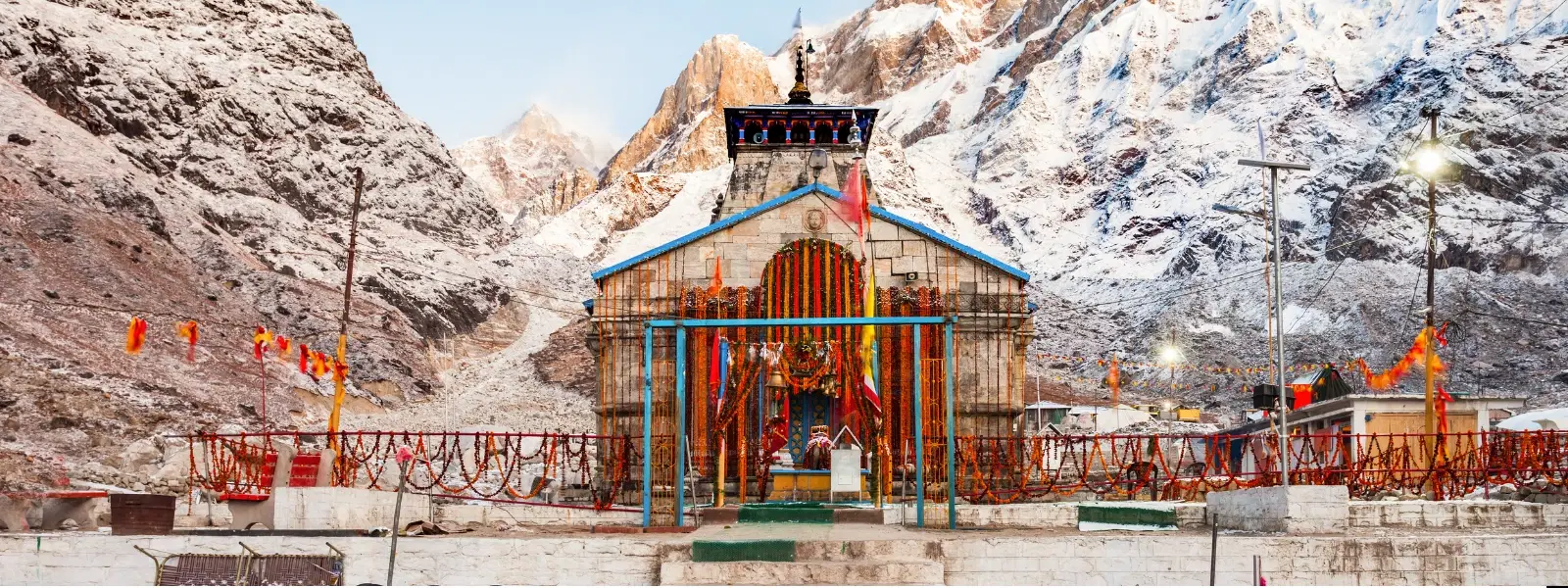
Hotels
•05 min read

Kedarnath is much more than a destination; it is a spiritual haven nestled among stunning Himalayan vistas. Pilgrims have long embarked on journeys here, drawn by the powerful energy of the ancient temple and the serene beauty that envelopes it. In this guide, we uncover the 7 best seasons to visit Kedarnath for a perfect pilgrimage, offering an in-depth look into Kedarnath weather conditions, travel tips, and accommodation options. Whether you’re planning a trekking expedition or a helicopter ride to the temple, choosing the right time can greatly enhance your spiritual experience.
When planning a Kedarnath trip, timing plays a pivotal role. Different seasons bring varying weather conditions, crowd levels, and accessibility which directly impact your pilgrimage experience. From the ideal times for trekking to the moments when the temple is bustling with devotees, aligning your trip with the ideal time for a Kedarnath pilgrimage ensures that you fully absorb the spiritual essence of the journey.
Kedarnath weather is known for its dramatic shifts. The temperature can soar during the summer months and drop to freezing levels during the winter. Rainfall in the monsoon season may enhance the region's lush greenery, but heavy precipitation may also hinder temple access and trekking routes. A clear understanding of these conditions ensures that you choose a window that best matches your travel plans and spiritual aspirations.
Summer is revered as the prime time to visit Kedarnath. Not only does the weather offer clear skies and pleasant temperatures, but this period also marks the opening of the Kedarnath temple. The trail is filled with the energy of fellow pilgrims, creating a vibrant atmosphere steeped in devotion and community spirit. Whether you opt for trekking or helicopter travel, summer provides the best conditions for every step of your journey.
During the summer months, temperatures typically range from warm to mildly cool, making it the ideal season for outdoor activities. The clear skies not only ease the trekking experience but also offer breathtaking views of the surrounding Himalayan peaks. The combination of clear weather and accessible routes makes this the best season to plan your Kedarnath trip.
For a seamless summer pilgrimage, ensure you pack light trekking gear, hydration essentials, and sun protection. Early booking of accommodation is advised since this season draws large crowds. Keep a flexible itinerary, as the vibrant activity of the season may mean occasional delays or changes in schedule.
The monsoon season transforms Kedarnath into a lush, green paradise. With fewer crowds than summer, this season appeals especially to adventure seekers who relish the idea of exploring nature in its most vibrant form. However, heavy rainfall can disrupt trekking paths, and potential landslides might pose risks for some travelers. Weighing these benefits and challenges is key to planning a safe and enjoyable monsoon pilgrimage.

Expect frequent rains and overcast skies during the monsoon months. The persistent drizzle contributes to the area's unique beauty, but it also means that the trekking trails may be slippery and challenging. It is essential to monitor local weather updates closely while traveling in this period.
For those venturing during monsoon, packing waterproof gear, sturdy trekking shoes, and extra layers is a must. Opt for reliable accommodation and consider hiring local guides familiar with the changing landscape. Embrace flexibility in your plans and always prioritize safety over schedule.
Autumn is truly a hidden gem among Kedarnath pilgrimage seasons. With the aftermath of monsoon rains and before the chill of winter sets in, autumn offers a serene and reflective ambiance. The tranquil atmosphere, combined with fewer crowds, allows for an immersive spiritual experience, ideal for meditation and self-reflection.
Autumn in Kedarnath is characterized by mild temperatures and clear skies, making it perfect for trekking and sightseeing. The refreshing climate and beautiful transitional landscapes draw those who wish to enjoy a peaceful pilgrimage without the hustle and bustle of peak tourist season in Kedarnath.
Visitors during autumn should prepare for slightly cooler temperatures, especially during early mornings and evenings. Booking hotels near Kedarnath temple well in advance is beneficial as accommodations tend to fill up quickly during this season. Dressing in layers and carrying a warm jacket will ensure a comfortable journey.
For those captivated by the beauty of snow, winter in Kedarnath offers a dramatic shift in scenery. While the main temple remains closed due to heavy snowfall, the winter shrine in Ukhimath attracts devotees and adventurers alike. Despite the challenges, snow-covered landscapes and a quiet atmosphere provide a unique experience for the intrepid traveler.
Winter in Kedarnath is harsh with sub-zero temperatures and heavy snowfall. The cold conditions make trekking particularly challenging, and the routes leading to the shrine can be treacherous. These weather conditions are a significant factor when considering a pilgrimage during this season.
Visiting Kedarnath in winter has its pros and cons. While the snowy retreat offers stunning winter landscapes, the extreme cold and difficult access are major considerations. If snow trekking and a helicopter trip appeal to you, proper preparation is essential to ensure safety and comfort.

A wide range of accommodation options is available near Kedarnath temple. From cozy guesthouses to well-equipped hotels, pilgrims have several choices. The availability and pricing differ with each season. During peak times like summer and autumn, booking ahead is advisable, while off-peak seasons may offer more flexibility and lower rates.
General tips for a successful Kedarnath pilgrimage include packing appropriate clothing for sudden weather changes and managing altitude sickness with the help of a travel doctor if needed. Always have a copy of local emergency contacts and avoid overcrowded routes by planning your journey during non-peak hours. Making informed decisions by considering the season-specific challenges and benefits can streamline your pilgrimage experience.
Pro Tip for Pilgrims: Did You Know? Kedarnath is best visited in summer (April-June) for a vibrant pilgrimage experience and in autumn (October-November) for a serene, crowd-free visit. Each season offers a unique charm—plan accordingly for a memorable journey.
Summer (April-June) is the best season due to favorable weather and the temple being open, though autumn offers a more serene experience.
Kedarnath tends to be less crowded during the monsoon and autumn months, but weather conditions should be taken into account.
Snowfall is most common between late December and February, perfect for those who enjoy a snowy retreat.
The Kedarnath temple typically operates from late April to early November, depending on weather conditions.
Yes, October offers mild weather, fewer crowds, and a tranquil environment, making it an excellent month to visit.
In summary, each season offers a distinct flavor for your Kedarnath pilgrimage. While summer provides ideal trekking conditions and a vibrant atmosphere, autumn stands out for its serene and reflective environment. The monsoon season beckons adventurous souls with lush scenery, and winter promises a snow-covered spectacle for those willing to brave the cold. By understanding the pros and cons of each season and planning accordingly, you can tailor your journey to suit your personal pilgrimage needs.